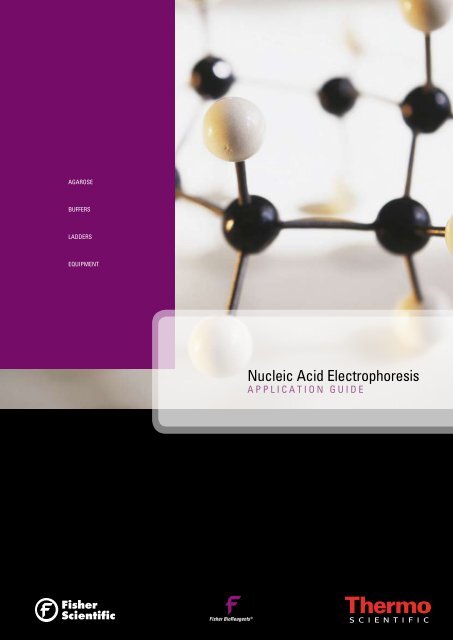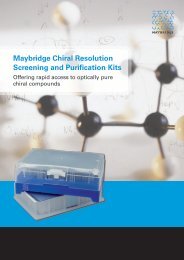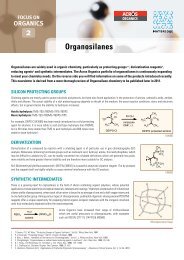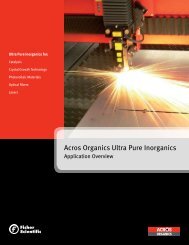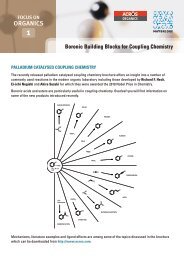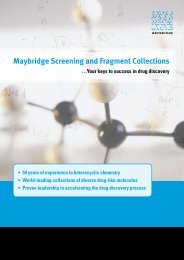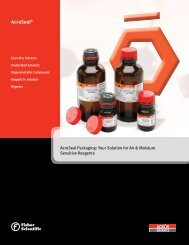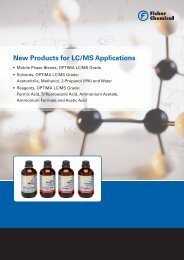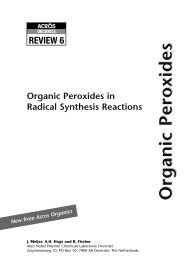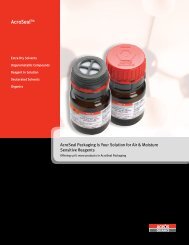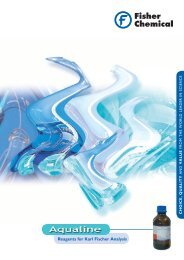Download PDF - Acros Organics
Download PDF - Acros Organics
Download PDF - Acros Organics
Create successful ePaper yourself
Turn your PDF publications into a flip-book with our unique Google optimized e-Paper software.
AGAROSE<br />
BUFFERS<br />
LADDERS<br />
EQUIPMENT<br />
Nucleic Acid Electrophoresis<br />
APPLICATION GUIDE
Reagents: Agarose<br />
Thermo Scientific and Fisher Scientific products deliver an end-to-end solution<br />
that can meet your most demanding electrophoresis requirements.<br />
You can depend on our expertise in electrophoresis instruments along with<br />
ultra-pure reagents that are pre-qualified for your applications. This guide is<br />
designed to help you select the right products from our best-in-class array of<br />
laboratory equipment and bioreagents.<br />
Fisher BioReagents ® offers three different<br />
grades of agarose that are functionally<br />
tested and pre-qualified for specific<br />
applications.<br />
Agarose grades used in electrophoresis<br />
of nucleic acids<br />
Genetic Analysis Grade—agarose that<br />
yields biologically active DNA or RNA.<br />
Testing includes enzymatic performance<br />
measurements.<br />
Molecular Biology Grade—suitable for<br />
analytical separation of DNA or RNA.<br />
PCR Grade—the original agarose for<br />
analytical separation of PCR amplicons (
Reagents: Buffers<br />
Our Fisher BioReagents line of electrophoresis buffers is available in various<br />
package configurations to suit all budgets. Choose from the most economical<br />
powder components, through concentrated stock solutions, to ready-to-use<br />
concentrations in specially designed containers featuring faucets for easy<br />
dispensing.<br />
Two buffers commonly used for DNA<br />
agarose electrophoresis are Tris-acetate<br />
with EDTA (TAE; 40mM Tris-acetate, 1mM<br />
EDTA) and Tris-borate with EDTA (TBE, 89mM<br />
Tris-borate, 2mM EDTA). Because the pH<br />
of these buffers is neutral, the phosphate<br />
backbone of DNA has a net negative charge<br />
and migrates toward the anode. TAE and<br />
TBE have different properties which makes<br />
one more suitable than the other for a<br />
specific purpose.<br />
MOPS is a commonly used buffer system<br />
for RNA electrophoresis using formaldehyde<br />
or formamide denatured RNA. It is important<br />
to use RNase-free chemicals, water, and<br />
containers when preparing the buffer<br />
solution. The typical formulation of a 10X<br />
MOPS running buffer is 0.4M MOPS (pH 7.0),<br />
0.1M sodium acetate, and 0.01M EDTA.<br />
Buffer Suggested Uses Properties<br />
The denaturing system chosen depends on the<br />
purpose of the RNA experiment and the size<br />
of the RNA fragment being separated.<br />
Formaldehyde denaturation is<br />
suitable if RNA samples are<br />
to be recovered. Formamide<br />
denaturation is suitable<br />
if the RNA needs to<br />
retain its<br />
biological<br />
activity.<br />
TAE DNA recovery. Low buffering capacity.<br />
Electrophoresis of large DNA (>12 kb).<br />
Recirculation may be necessary for<br />
extended run times (>6 hr).<br />
TBE Electrophoresis of small DNA (< 1kb). Decreased DNA mobility.<br />
Increased resolution of small DNA (< 1kb).<br />
High buffering capacity – no recirculation required<br />
for extended run times.<br />
MOPS Electrophoresis of formaldehyde denatured RNA. Buffer is low in ionic strength.<br />
Recirculation of buffer may be necessary.<br />
Suggested Agarose Concentrations<br />
The optimal gel concentration depends on the size of the DNA fragments to be resolved.<br />
Cat. No. Main Application DNA Size Range Final Agarose Final Agarose<br />
in Base Pairs Concentration % (W/V) Concentration % (W/V)<br />
1x TAE buffer<br />
1x TBE buffer<br />
BP1360 Low melting temperature agarose. 500-1,000 2.5 2.0<br />
Certified recovery of small nucleic 150-700 3.0 2.5<br />
acid fragments. 100-450 3.5 3.0<br />
Outstanding resolution. 70-300 4.0 3.5<br />
10-100 4.5 4.0<br />
8-50 5.0 4.5<br />
BP165 Low melting temperature agarose. 500-25,000 0.75 0.70<br />
Broad separation range. 300-20,000 1.00 0.85<br />
Ideal for DNA and RNA recovery 200-12,000 1.25 1.00<br />
after electrophoretic separation. 150-6,000 1.50 1.25<br />
100-3,000 1.75 1.50<br />
50-2,000 2.00 1.75<br />
BP1356 Suitable for routine nucleic acid 1,000-23,000 0.60 0.50<br />
BP160 electrophoresis applications with 800-10,000 0.80 0.70<br />
broad separation range. 400-8,000 1.00 0.85<br />
300-7,000 1.20 1.00<br />
200-4,000 1.50 1.25<br />
100-3,000 2.00 1.75<br />
Buffers for Nucleic Acid Applications<br />
Cat. No. Concentration Tris-Borate<br />
*Pre-weighed powder in poly bottle. Dissolve in water.<br />
** Pre-weighed powder in foil pack. Dissolve in water.<br />
EDTA<br />
TBE<br />
BP2430-1 1X 1L<br />
BP2430-4 1X 4L<br />
BP2430-20 1X 20L<br />
BP1396-86 5X 1L*<br />
BP1333-1 10X 1L<br />
BP1333-4 10X 4L<br />
BP1333-20 10X 20L<br />
BP1334-1 10X 1L**<br />
TAE<br />
BP2434-4 1X 4L<br />
BP2434-20 1X 20L<br />
BP1335-500 10X 500mL<br />
BP1335-1 10X 1L<br />
BP1335-4 10X 4L<br />
BP1335-20 10X 20L<br />
BP1330-1 25X 1L<br />
BP1332-500 50X 500mL<br />
BP1332-1 50X 1L<br />
BP1332-4 50X 4L<br />
BP1332-20 50X 20L<br />
BP1331-1 25X 1L**<br />
Cat. No. Description Size<br />
Mops<br />
BP308-100 Powder 100g<br />
BP308-500 Powder 500g<br />
BP2900-500 10x Buffer Solution 500mL<br />
BP2900-1 10x Buffer Solution 1L<br />
Water<br />
BP2484-50 Nuclease-Free 50mL<br />
BP2484-100 Nuclease-Free 100mL<br />
BP2470-1 DNA-Grade 1L<br />
BP561-1 RNA-Grade 1L<br />
Formaldehyde<br />
BP531-25 37% by weight 25mL<br />
BP531-500 37% by weight 500mL
Reagents: LADDERS<br />
To achieve the most accurate qualitative<br />
and quantitative analysis via agarose gel<br />
electrophoresis, the appropriate DNA or<br />
RNA standard is required.<br />
Fisher BioReagents provides a wide range<br />
of standards, including routine DNA ladders<br />
for quick size and quality assessment as<br />
well as Fisher BioReagents exACTGene DNA<br />
ladders that allow for quantitative analysis.<br />
Fisher BioReagents RiboLadders RNA<br />
Standards<br />
These standards can be used to assess<br />
single-stranded RNA molecules on both<br />
native and denaturing agarose gels.<br />
These unique RNA standards are lyophilized<br />
to reduce thawing-related degradation, to<br />
prolong shelf life and to ensure consistent<br />
performance.<br />
Cat. No. Application Size Range Number of Bands Number of Loadings<br />
sizing unknown RNA fragments<br />
BP2810-50 Small RNA fragments 0.1 – 1kb 8 50<br />
BP2811-50 Large RNA fragments 0.2 – 4kb 9 50<br />
Routine DNA Ladders<br />
RiboLadders RNA Standards<br />
BP2581<br />
Bases<br />
2,000<br />
1,550<br />
1,400<br />
BP2582<br />
Bases<br />
10,000<br />
8,000<br />
6,000<br />
BP2810<br />
Bases<br />
4,000<br />
3,000<br />
BP2811<br />
Bases<br />
1,000<br />
800<br />
1,000<br />
750<br />
500<br />
400<br />
300<br />
200<br />
100<br />
50<br />
4,000<br />
3,000<br />
2,000<br />
1,550<br />
1,400<br />
1,000<br />
750<br />
500<br />
400<br />
300<br />
200<br />
2,000<br />
1,500<br />
1,000<br />
800<br />
600<br />
400<br />
600<br />
500<br />
400<br />
300<br />
200<br />
100<br />
50<br />
200<br />
100
Reagents: LADDERS<br />
exACTGene ® and Routine DNA Ladders<br />
Ready-to-use (pre-mixed with the loading dye), room temperature, stable DNA ladders<br />
are available for all common electrophoresis applications.<br />
Cat. No. Application Size Range Number of Number of<br />
Bands<br />
Loadings<br />
exACTGene DNA ladders are ideal for<br />
qualitative analysis, quantitative estimation,<br />
and size assessment<br />
BP2570-100 PCR fragment analysis 25-650bp 14 100/10uL<br />
BP2571-100 PCR fragment analysis, small DNA digests 25-1000bp 12 100/10uL<br />
BP2572-100 Quick check of PCR or enzyme digestion results 50-2000bp 8 100/10uL<br />
BP2573-100 General purpose, small DNA fragments 100-1000bp 10 100/10uL<br />
BP2574-100 Fast run times, small DNA fragments 100-2000bp 11 100/10uL<br />
BP2575-100 Clone identification 100-2686bp 14 100/10uL<br />
BP2576-100 Large size PCR or cloning 300-5000bp 10 100/10uL<br />
BP2577-100 Small and large cloning application 100-5000bp 16 100/10uL<br />
BP2578-100 General purpose, large digested DNA 300-10,000bp 13 100/10uL<br />
BP2579-100 General purpose, wide size range 100-10,000bp 19 100/10uL<br />
BP2580-100 General purpose, extra-large fragments 300-24,000bp 15 100/10uL<br />
Routine DNA ladders are designed for<br />
qualitative analysis and size assessment<br />
BP2581-200 Small fragments, quick size assessment 50-2000bp 11 200/5uL<br />
BP2582-200 Quick size assessment of broad size range 50-10,000bp 16 200/5uL<br />
For Lambda DNA digests or other DNA markers and ladders not containing loading dye, please visit www.fishersci.com and type: BP2553-100 in the search box.<br />
exACTGene DNA Ladders<br />
BP2579 bp<br />
10,000 43<br />
8,000 31<br />
6,000 28<br />
5,000 41<br />
4,000 36<br />
3,000 31<br />
2,500 26<br />
2,000 23<br />
1,500 22<br />
1,000 35<br />
900 26<br />
800 25<br />
700 31<br />
600 18<br />
500 35<br />
400 12<br />
300 17<br />
200 12<br />
100 7<br />
ng/10µL<br />
BP2578 bp ng/10µL<br />
10,000 58<br />
8,000 53<br />
6,000 46<br />
5,000 67<br />
4,000 56<br />
3,000 47<br />
2,500 41<br />
2,000 34<br />
1,500 29<br />
1,000 18<br />
700 13<br />
500 23<br />
300 14<br />
BP2573 bp ng/10µL<br />
1,000 77<br />
900 67<br />
800 63<br />
700 55<br />
600 47<br />
500 70<br />
400 34<br />
300 26<br />
200 33<br />
100 28<br />
BP2571 bp<br />
1,000 90<br />
900 66<br />
800 58<br />
700 48<br />
600 41<br />
500 69<br />
400 28<br />
300 21<br />
200 28<br />
100 20<br />
50 14<br />
25 15<br />
ng/10µL
equipment<br />
Voltage Table<br />
The table (below) provides recommended voltages and buffers according to DNA size and<br />
application. The distance used to determine the voltage gradients is the distance between<br />
electrodes, not the gel length. If the voltage is too high, band streaking may occur for large DNA<br />
sizes (>12kb). When the voltage is too low, the mobility of small (< 1kb) DNA is reduced, and<br />
band broadening will occur due to dispersion and diffusion.<br />
Gel Size Voltage Recovery Buffer Analytical Buffer<br />
12 kb 1-2V/cm TAE TAE<br />
© Thermo Fisher Scientific Inc. All rights reserved. All trademarks are the property of Thermo Fisher Scientific Inc. and its subsidiaries.<br />
Thermo Fisher Scientific<br />
<strong>Acros</strong> <strong>Organics</strong><br />
Geel West Zone 2<br />
Janssen Pharmaceuticalaan 3a<br />
2240 Geel – Belgium<br />
Tel: +32 14 57 52 11<br />
Fax: +32 14 59 26 10<br />
www.acros.com<br />
For more information, please contact your local distributor.


